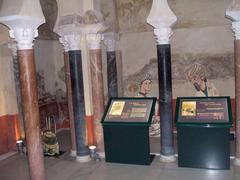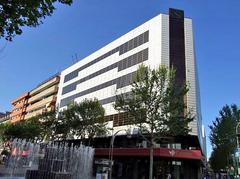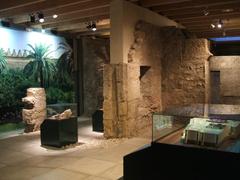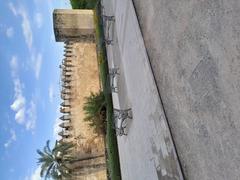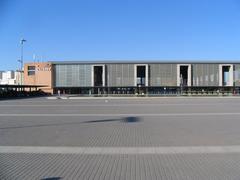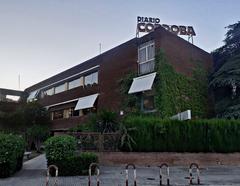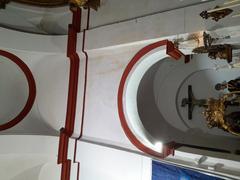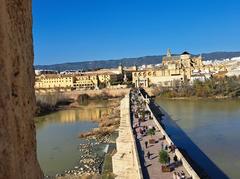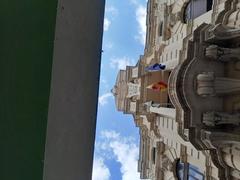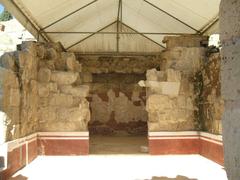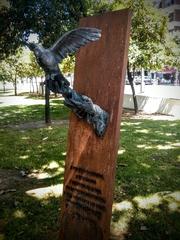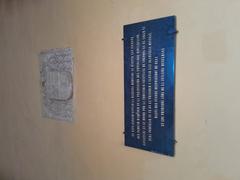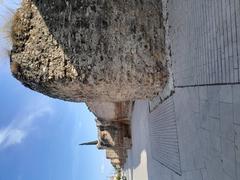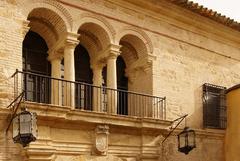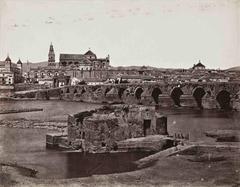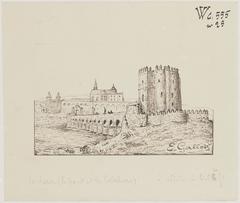Templo Romano Calle Claudio Marcelo: Visiting Hours, Tickets, and Historical Significance in Córdoba, Spain
Date: 04/07/2025
Introduction
Located in the vibrant heart of Córdoba, the Templo Romano de la Calle Claudio Marcelo is one of the city’s foremost Roman archaeological treasures. This monumental site provides a striking window into the splendor of ancient Roman civilization and the significance of imperial cult worship in Hispania. Built in the mid-1st century CE, when Córdoba was a flourishing provincial capital known as Colonia Patricia Corduba, the temple was both a civic and religious landmark—its grandeur reflecting Córdoba’s strategic importance within the Roman Empire.
The temple’s towering Corinthian columns, crafted from high-quality marble sourced from quarries in Luni-Carrara, Almadén-Estremoz, and the Córdoba region, bear witness to the city’s wealth and ambition. Today, the restored remains invite history enthusiasts, architecture aficionados, and the curious traveler to experience Córdoba’s Roman legacy firsthand, with accessible facilities, guided tours, and engaging cultural events.
This guide provides comprehensive information on the Templo Romano’s historical context, architectural highlights, ticketing, visiting hours, accessibility, and nearby attractions—helping you plan an insightful and memorable visit. For official updates and resources, refer to the Córdoba Tourism Website and the detailed Templo Romano Córdoba guide.
Table of Contents
- Introduction
- Historical Background
- Visiting Information
- Archaeological Discovery and Restoration
- Visitor Experience and Tips
- Frequently Asked Questions (FAQ)
- Summary and Further Resources
- References
Historical Background
Origins and Urban Context
The Templo Romano was constructed during the mid-1st century CE, a period that saw Córdoba rise as the provincial capital of Hispania Baetica (Wikipedia). Its location on Calle Claudio Marcelo, adjacent to the modern City Hall (Ayuntamiento), places it within what was once the Provincial Forum—the administrative and ceremonial hub of Roman Corduba (Arte en Córdoba). With the Via Augusta running nearby, the temple greeted visitors arriving from across the Roman world.
Construction and Architectural Features
The temple exemplifies Augustan and early Imperial architectural trends, with a hexastyle Corinthian façade—six columns at the front and ten along each side (Wikipedia). Built almost entirely of marble, it was elevated on a high podium measuring approximately 32 by 16 meters, accessed by a grand staircase. Noteworthy is the innovative use of “antérides,” or fan-shaped buttresses, to support the structure on the city’s sloping terrain (Arte en Córdoba).
Key features:
- Corinthian Columns: Eleven reconstructed columns today, showcasing intricate acanthus capitals.
- High Podium: Elevates the temple above the forum, symbolizing its sacred status.
- Pronaos (Portico): Recently restored to provide a sense of the original approach.
- Altar (Ara): Located in front for religious sacrifices.
The craftsmanship and scale set a benchmark in Hispania and still inspire awe (Travel Córdoba).
Function and Religious Significance
Dedicated to the imperial cult, the temple honored the deified Emperor Claudius and his successors (Nomads Travel Guide). It played a dual role as a religious sanctuary and a symbol of the city’s loyalty to Rome, hosting public rituals and festivals that reinforced local identity within the empire (Spain.info).
Visiting Information
Opening Hours and Tickets
- Hours: Tuesday to Sunday, 10:00 AM – 6:00 PM (last entry 5:30 PM). Closed Mondays and some public holidays. Seasonal variations may apply.
- Tickets: General admission is approximately €3. Discounts are available for students, seniors, and groups. Córdoba residents and children under 12 may enter free.
- Purchase: Tickets can be bought on-site or online via the official tourism website.
Location and Accessibility
- Address: Calle Claudio Marcelo, next to the Ayuntamiento (Town Hall), in Córdoba’s historic center.
- Getting There: Easily accessible by foot from the Mezquita-Catedral and other city landmarks. Public buses and taxis serve the area.
- Accessibility: The main viewing areas are accessible by ramps and designated pathways. An alternative accessible route is available via Calle Nueva. Some uneven ancient surfaces remain; visitors with mobility needs are encouraged to inquire in advance.
Guided Tours and Audio Guides
- Guided Tours: Available in Spanish, English, and additional languages. Book through the Córdoba tourism office or on-site.
- Audio Guides: Rentable on-site or downloadable via the official Córdoba tourism app.
Nearby Attractions
- Mezquita-Catedral de Córdoba: Iconic mosque-cathedral.
- Roman Bridge of Córdoba: Historic crossing over the Guadalquivir.
- Alcázar de los Reyes Cristianos: Royal fortress.
- Plaza de las Tendillas: Lively city square.
- Jewish Quarter: Medieval streets rich in heritage.
Photography Tips
- Best moments: Golden hour and nighttime, when the columns are illuminated.
- Angles: The plaza below and nearby terraces offer panoramic shots of the temple and Córdoba’s skyline.
Special Events
The temple hosts cultural activities such as Roman reenactments, open-air concerts, and guided night tours, especially during spring fairs and Semana Santa. Check the Córdoba Tourism Website for current events.
Archaeological Discovery and Restoration
Rediscovered in 1951 during City Hall expansion, the temple’s significance was revealed through subsequent archaeological work. Architect Félix Hernández oversaw the mid-20th-century restoration, reconstructing eleven columns to their original scale (Siente Córdoba). Recent projects, funded through EU Next Generation funds, have further improved visitor facilities and accessibility, with the latest works expected to conclude in 2024 (eldiariodeandalucia.com).
Visitor Experience and Tips
- Allow 30–60 minutes for your visit.
- Wear comfortable footwear due to uneven terrain.
- Respect preservation barriers and signage.
- Combine your visit with nearby sites for a fuller experience.
- Check for guided tour schedules and book in advance, if possible.
- Evening visits offer atmospheric views and excellent photo opportunities.
Frequently Asked Questions (FAQ)
Q: Is there an entrance fee?
A: Yes, general admission is €3; free for Córdoba residents and children under 12. Discounts apply.
Q: What are the opening hours?
A: Tuesday to Sunday, 10:00 AM to 6:00 PM. Closed Mondays and holidays.
Q: Are guided tours available?
A: Yes, in multiple languages. Book ahead for guaranteed spots.
Q: Is the site accessible for wheelchair users?
A: Main areas are accessible, but some ancient surfaces may be uneven.
Q: What else can I see nearby?
A: Mezquita-Catedral, Roman Bridge, Plaza de las Tendillas, and the Jewish Quarter are all within walking distance.
Summary and Further Resources
The Templo Romano de la Calle Claudio Marcelo stands as a testament to Córdoba’s Roman heritage and ongoing commitment to preservation. Its monumental columns, evocative setting, and integration into the city’s contemporary life make it a must-visit for anyone exploring Andalusia. Visitors benefit from detailed interpretation, guided tours, and the opportunity to connect directly with Córdoba’s layered past.
For up-to-date information on hours, tickets, and events, visit the Official Córdoba Tourism Website. For deeper exploration, consult resources like Nomads Travel Guide and Templos Romanos en Hispania.
References
- Córdoba Tourism Website
- Templos Romanos en Hispania: Templo de Claudio Marcelo
- Nomads Travel Guide: Templo Romano de Córdoba
- eldiariodeandalucia.com: Qué ver en el Templo Romano de Córdoba
- Wikipedia: Roman Temple of Córdoba
- Spain.info: Roman Temple Córdoba
- Arte en Córdoba: Roman Temple Claudio Marcelo
- Travel Córdoba: Roman Temple
- Siente Córdoba: The Roman Temple
- beticaromana.org: Templo Romano de Claudio Marcelo
